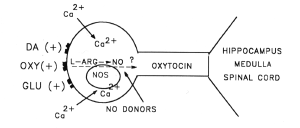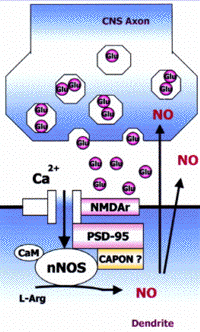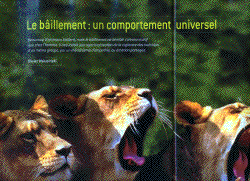-
-

- Penile erection and yawning are two
different behavioural patterns that often occur
concomitantly in physiological and experimental
conditions. Depending on the context in which
penile erection occurs, different neural and/or
humoral mechanisms may participate in its
regulation. Yawning alone or associated with
stretching is considered an ancestral vestige,
surviving through evolution, that subserves the
purpose of arousal, although its role is not
entirely certain.
-
- Among substances that induce both these
responses the best known are dopamine receptor
agonists, oxytocin, adrenocorticotropin and
related peptides, N methyl-D-aspartic acid and
serotonin receptor agonists. Interestingly, the
paraventricular nucleus of the
hypothalamus (PVN) seems to play a key role
in these behavioural responses when they are
induced by the dopamine receptor agonists,
N-methyl-D-aspartic acid and oxytocin, but not
when they are induced by adrenocorticotropin or
serotonin receptor agonists.
-
- Dopamine agonists, NMDA and oxytocin
given at doses that induce yawning, increase NO
production in the PVN. Conversely, the
opiate morphine, which prevents yawning induced
by dopamine agonists, oxytocin and NMDA, also
prevents the increase in the paraventricular NO
production induced by these compounds.
-
- NO donors, such as nitroglycerin, sodium
nitroprusside and hydroxylamine, induce yawning
when injected into the PVN apparently by
activating oxytocinergic transmission. Nitric
oxide (NO) acts as an intracellular rather than
an intercellular modulator inside the
paraventricular hypothalamic nucleus (PVN)
oxytocinergic neurons in which NO is formed to
facilitate the expression of this
phylogenetically old stereotyped event.
-
-
- Bâillements
et oxyde nitrique (NO)
-
- L'érection pénienne et le
bâillement sont deux comportements qui
apparaîssent fréquemment
simultanément de façon
physiologique ou expérimentalement.
Suivant les circonstances au cours desquelles
l'érection pénienne
apparaît, différents
mécanismes neuronaux et/ou humoraux
interviennent dans sa régulation. Le
bâillement isolé ou associé
avec des étirements est
considéré comme un vestige
ancestral, survivant au travers de
l'évolution, et qui participe à la
stimulation de l'éveil, bien que cette
fonction ne soit pas complètement
certaine.
-
- Parmi toutes les substances qui induisent
érection pénienne et
bâillement, les plus connues sont les
agonistes dopaminergiques, l'ocytocine, l'ACTH
et différents peptides, le NMDA, les
agonistes sérotininergiques. Plus
précisément, le noyau
paraventriculaire de l'hypothalamus (PVN)
semble jouer un rôle clé dans ces
réponses comportementales quand elles
sont induites par les agonistes dopaminergiques,
le NMDA et l'ocytocine mais pas quand elles sont
induites par l'ACTH ou les agonistes
sérotoninergiques.
-
- Les agonistes dopaminergiques, le NMDA et
l'ocytocine, donnés à des doses
qui déclenchent les bâillements,
accroissent la production d'oxyde nitrique (NO)
dans le PVN. A contrario, les opioïdes
qui empêchent l'induction des
bâillements par les agonistes
dopaminergiques, le NMDA ou l'ocytocine
préviennent également
l'augmentation de la production de NO dans le
PVN.
-
- Les donneurs de NO comme la
nitroglycérine, le nitroprussiate de Na,
ou l'hydroxylamine induisent des
bâillements quand ils sont injectés
dans le PVN, apparemment en activant la
transmission ocytocinergique. NO agit
plutôt comme modulateur intracellulaire
que comme médiateur intercellulaire, en
particulier au sein des neurones
ocytocinergiques du PVN où le NO est
formé pour faciliter l'expression de ce
comportement stéréotypé
ancien.
- Nitric
oxide synthase inhibitors prevent apomorphine
and oxytocin-induced penile erection and yawning
in male rats Melis MR, Argiolas A
Brain Res Bull1993; 32; 1;
71-74
- Prevention
by ng-nitro-l-arginine methyl ester of
apomorphine- and oxytocin-induced penile
erection and yawning: site of action in the
brain Melis MR, R Stancampiano, A Argiolas
Phamcol Biochem Behav 1994; 48;
3; 799-804
- Nitric
oxide synthase inhibitors prevent
N-methyl-D-aspartic acid induced penile erection
and ya wning in male rats Melis MR et al
Neuroscience letters1994; 179;
9-12
- Role
of nitric oxide in penile erection and yawning
induced by 5-HT1c receptor agonists in male
rats Melis MR, Argiolas A
Naunyn-Schmiedeberg's arch
Pharmacol1995; 351; 439-445
- Nitric
oxide donors induce penile erection and yawning
when injected in the central nervous system of
male rats Melis MR et Argiolas A
Europ J Pharmacol 1995; 294;
1-9
- Nitric
oxide is involved in the ACTH-induced behavioral
syndrome R Poggioli Peptides
1995; 16; 7; 1263-1268
- Nitroglycerin-induced
penile erection and yawning in male rats:
mechanisrn of action in the brain Melis
MR, et al Brain Res Bull 1995;
36; 6; 527-531
- Dopamine
agonists increase nitric oxide production in the
paraventricular nucleus of the hypothalamus:
correlation with penile erection and yawning
MR Melis et al Europ J Neurosci
1996; 8; 2056-2063
- Nitric
oxide (NO) and central dopamine (DA) D3 receptor
reactivity to quinpirole in rats Brus R et
al Act Neurobiol Exp 1996; 56;
15-19
- Role
of central nitric oxide in the control of penile
erection and yawning Melis MR, Argiolas A
Prog Neuropsycho pharmacol Biol
Psychiatry 1997; 21; 6; 899-922
- Prevention
by morphine of apomorphine- and oxytocin-induced
penile erection and yawning: involvement of
nitric oxide Melis MR et al
Naunyn-Schmiedeberg's arch
Pharmacol1997; 600; 355-595
- Prevention
by morphine of N-Methyl-D-Aspartic Acid induced
penile erection and yawning: involvement of
Nitric Oxide MR Melis et al
Brain Research Bull1997; 44; 6;
689-694
- Oxytocin
increases nitric oxide production in the
paraventricular nucleus of the hypothalamus of
male rats: correlation with penile erection and
yawning Melis MR et al
Regulatory Peptides 1997; 69;
105-11
- Sereotyped
yawning responses induced by electrical and
chemical stimulation of paraventricular nucleus
of the rat Sato-Suzuki I, Kita I, et al J
Neurophysiol
1998; 80, 5;
2765-2775
- Yawning
role of hypothalamic paraventricular nitric
oxide Melis MR, Argiolas A
Acta Pharmacologica Sinica 1999;
20; 9; 778-788
- Yawning
responses induced by local hypoxia in the
paraventricular nucleus of the rat Kita I,
Sato-Suzuki et al. Behavioural
Brain Research 2000; 117; 1-2; 119 -
126
- Substance
P and its transglutaminase-synthesized spermine
derivative elicit yawning behavior via nitric
oxide in rat Mancuso F, Porta R et al
Peptides 2001; 22; 9;
1453-1457
- Reduction
of drug-induced yawning and penile erection and
of noncontact erections in male rats by the
activation of GABAA receptors in the
paraventricular nucleus: involvement of nitric
oxide Melis MR , A.Argiolas
Eur J Neurosci 2002; 15; 5;
852-860
-
-
- NO as a signalling
molecule
- in the nervous system
- Esplugues Juan V
- British Journal of
Pharmacology
- 2002; 135;
1079-1095
-
- «The discovery that
nitric oxide
(NO) functions as a signalling
molecule in the nervous system has radically
changed the concept of neural communication.
Indeed, the adoption of the term nitrergic for
nerves whose transmitter function depends on the
release of NO or for transmission mechanisms
brought about by NO emphasizes the specific
characteristics of this mediator. The physical
properties of NO prevent its storage in
lipid-lined vesicles and metabolism by
hydrolytic degradatory enzymes. Therefore,
unlike established neurotransmitters, NO is
synthesized on demand and is neither stored in
synaptic vesicles nor released by exocytosis,
but simply diffuses from nerve terminals. The
distance of this NO diffusion (40 Ð 300
µm in diameter) implies that structures in
the vicinity of the producing cell, both
neuronal and non-neuronal, are influenced
following its release. This suggests that, as
well as acting as a neurotransmitter, NO has a
neuromodulatory role. In addition, it diffuses
into rather than binds with protein receptors on
adjacent cells, and most of its known actions
are the consequence of interplay with
intracellular targets that would usually be
regarded as secondary messengers. The activity
of conventional neurotransmitters is terminated
either by re-uptake mechanisms or enzymatic
degradation while inactivation of NO follows
reaction with a substrate. There are multiple
points at which biological control can be
exerted over the production and activity of
conventional neurotransmitters. However, control
of the synthesis of NO is the key to regulating
its activity.»
 - Activation of nNOS in the
CNS. Release of glutamate activates NMDA
receptors (NMDAr), and the consequent flux of
Ca2+ entering the ion channel activates nNOS,
which is linked to the receptor via the
postsynaptic density protein PSD-95. It is
possible that NO bioactivity feeds back to
control the presynaptic neuron and the activity
of the channel. The protein CAPON is thought to
be selectively associated with nNOS and
regulates NO formation in neurones.
-
-

-
- Pour La
Science
- A lire, page 66,
dans le numéro 312, d'octobre
2003
|





